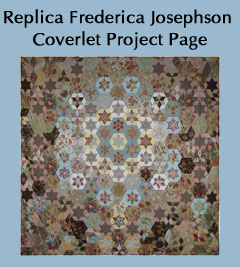The meeting was held to report on the progress of the help
that four committee members of the Quilt Study Group (Karen Fail, Annette Gero,
Sandra Lyons and Liz Bonner) have been giving the textile area of the Powerhouse Museum with research and documentation of
their quilts. In late 2010, we met Christina Sumner, the Principal Curator,
Design and Society, to discuss how we could help the Museum with its quilt
collection. Due to staff cutbacks, there was a need to improve the
documentation of the quilt collection and volunteers were needed to supplement
the work of that area, as they had already done in a previous project to
document the Museum’s rug collection.
Christina was delighted to accept our offer of assistance. After
we discussed how to best approach the work and learnt how to fill in the form to
make it easy for Christina to upload the information to the Museum’s computer
system, we then chose our quilts to study and document from a file of possible
contenders that Christina had selected.
Annette chose a patchwork quilt (98/48/1) made from military
uniforms that was similar to one in her collection. Karen chose a set of 3 quilts (2001/13/1) by
Barbara Macey called ‘Dream Series – Once in a Lifetime”. Sandra chose a
woollen machine-pieced, hand embroidered quilt (96/393/1) made by Jocelyn
Campbell. And Liz Bonner initially chose an undocumented North
England whole cloth quilt (A8645) made by Hannah Coulson but after
discovering on the National Quilt Register that 2 other quilts made by Hannah
had also been donated to the museum, decided to research and document all 3 of
Hannah’s quilts.
In February 2011 we visited the Museum’s quilt storage area
with Christina Sumner to view our chosen quilts and then our hard work of
research and documentation started.
Karen Fail ran the audience through the Powerhouse Museum’s
online quilt collection catalogue, then showed the documentation requirements –
the form used - and explained in detail the different sections we have to
complete.
Annette started the quilt presentations proper by showing
photos of her military quilt and the one she has researched for the Powerhouse Museum. The Powerhouse army quilt is
supposed to have been made in Tasmania
from war army uniforms from the British 90th Regiment of Foot c1870 by the
soldiers’ wives. The connection was made because some soldiers who fought in
the Crimean war were then given land grants in Tasmania in the 1860s. The quilt is hand
stitched from trousers and jackets but analysis, by Annette and a military
historian, suggests it was probably made in England and brought here as it is
also all made by "one hand". Comparison photographs of the 2 quilts
were shown and discussed.

Liz then talked about the 2 whole cloth and 1 strippy North
England quilts made by Hannah Coulson (1826-1903) which were brought to Australia
in 1912 by her daughter, Ruth Ritson, and which were donated to the Museum by
her granddaughter, Lavinia McFadyen in the late 1980s. The town of Allendale in Northumberland,
England, is famous for the design
of North England whole cloth quilts and
Hannah’s forebears lived in the area for generations as lead ore miners. After
covering the important dates in Hannah’s life (researched from various genealogical
websites) and the story of how the quilts were brought to Australia, Liz then covered the general
characteristics of North England quilts and
how they specifically relate to each of Hannah’s quilts. One of the quilts,
A8645, was only the third quilt in the museum’s collection and is quite a
spectacular example of the fine design and quilting of this type. From
Lavinia’s letters that accompanied the quilt donations, it appears there are
more of Hannah’s quilts in Australia,
possibly in the Inverell district of northern NSW, and initial enquiries there
have resulted in the discovery of one pink and white strippy. But the most
important wedding quilt Hannah made for her only son, John Reed, who died in Queensland in 1918, is
yet to be found.
 |
| Hannah Coulson (seated) |
Sandra then spoke about her research on the embroidered
woollen quilt, made by Jocelyn Campbell in 1990. There is a large amount of
information about the quilt on the Powerhouse
Museum’s website so
Sandra’s work mostly involved confirming those details. We inspected the
detailed photographs of the quilt with great interest and, because she was able
to talk to the quilt maker, Sandra was able to add to our knowledge of the
quilt itself and Jocelyn’s later quilts.
Then Karen spoke about Barbara Macey, her quilting process and
her quilts. Barbara has been quilting for 40 years and was a recipient of the
Rajah Award for outstanding service to the quilting community in 2010. We saw
photographs of some of her major quilts and Karen spoke at length about her
conversation with Barbara and her explanation of the techniques and choice of
materials in her quilts.












No comments:
Post a Comment